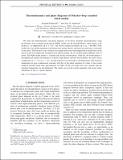Thermodynamics and phase diagrams of Polyakov-loop extended chiral models
Author(s)
Andersen, Jens O.; Folkestad, Aasmund Schiager
DownloadPhysRevD.99.054006.pdf (2.186Mb)
PUBLISHER_CC
Publisher with Creative Commons License
Creative Commons Attribution
Terms of use
Metadata
Show full item recordAbstract
We study the thermodynamics and phase diagrams of two-flavor quantum chromodynamics using the Polyakov-loop extended quark-meson (PQM) model and the Pisarski-Skokov chiral matrix (χM) model. At temperatures up to T≈2[subscript c] and baryon chemical potentials up to μ[subscript B]=400 MeV, both models show reasonable agreement with the pressure, energy density, and interaction measure as calculated on the lattice. The Polyakov loop is found to rise significantly faster with temperature in models than on the lattice. In the low-temperature and high baryon density regime, the two models predict different states of matter; The PQM model predicts a confined and chirally restored phase, while the χM model predicts a deconfined and chirally restored phase. At finite isospin density and zero baryon density, the onset of pion condensation at T=0 is at μ[subscript I]=1/2m[subscript π], and the transition is second order at all temperatures. The transition temperature for pion condensation coincides with that of the chiral transition for values of the isospin chemical potential larger than approximately 110 MeV. In the χM model, they also coincide with the transition temperature for deconfinement. The results are in good overall agreement with recent lattice simulations of the μ[subscript I]–T phase diagram.
Date issued
2019-03Department
Massachusetts Institute of Technology. Center for Theoretical Physics; Massachusetts Institute of Technology. Department of PhysicsJournal
Physical Review D
Publisher
American Physical Society
Citation
Folkestad, Åsmund, and Jens O. Andersen. “Thermodynamics and Phase Diagrams of Polyakov-Loop Extended Chiral Models.” Physical Review D, vol. 99, no. 5, Mar. 2019. © 2019 American Physical Society
Version: Final published version
ISSN
2470-0010
2470-0029